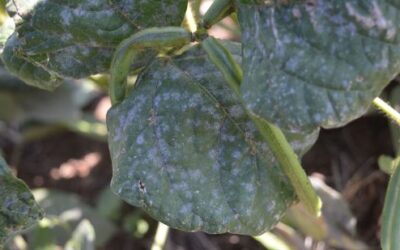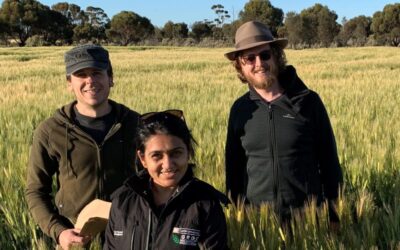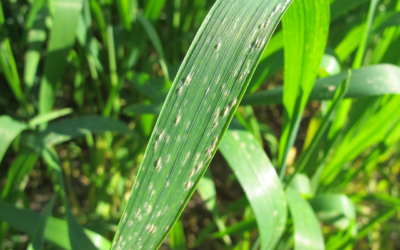WHEAT
Wheat Powdery Mildew (WPM)
Blumeria graminis f. sp. tritici
Manage
disease pressure
Minimise
fungicide use
Engage
with extension
Wheat Powdery Mildew (WPM)
Blumeria graminis f. sp. tritici
Wheat powdery mildew is a sporadic and important disease in years with conducive conditions, especially in the southern region.
Wheat powdery mildew is typically favoured by susceptible hosts, early sowing, mild and humid weather (15–22°C, relative humidity > 70%), dense crop canopies, good soil moisture profiles, higher nitrogen status and extended periods of humid and damp canopies.
It is spread predominantly via wind-borne spores, and survives on stubble and volunteer plants.
Note that wheat and barley powdery mildew are caused by different sub-species, so are crop specific.
Resistance status
Resistance – all Group 11 (QoI) fungicides in NSW, SA, Tas. and Vic.
Resistance – Group 3 fungicides propiconazole and tebuconazole in NSW and Vic.
Lab detection – Group 3 gateway mutation associated with reduced sensitivity detected in NSW, SA, Tas. and Vic.
FACT SHEETS
Wheat powdery mildew
Wheat powdery mildew is caused by the fungal pathogen Blumeria graminis f. sp. tritici. It is a sporadic disease but, in years with conducive conditions and especially in the southern and northern region, it can cause significant yield losses. Careful use and rotation of available fungicide actives will help control the spread of resistance in wheat powdery mildew.
Fungicide resistance in wheat
Numerous cases of reduced sensitivity and resistance to fungicides have been identified in Australia’s wheat growing regions. More cases are expected to arise as survey and detection methods improve, and if current fungicide use patterns continue. Fungicide resistance is a preventable issue, caused by repeatedly exposing a pathogen to a single fungicide active or to the chemical actives of a single Mode of Action (MoA) group.
Fungicides in Australia
Fungicides are a valuable tool in crop protection worldwide. However, most are vulnerable to the pathogens they target developing fungicide resistance, so responsible management is essential for preserving ongoing efficacy. There is a limited number of fungicide Mode of Action groups registered for use on crops in Australia.
Fungicide resistance
Fungicide resistance is a serious issue that can affect crop yields in the short term, while impacting on the long term viability of registered fungicides. Understanding how fungicide resistance develops, how it places additional pressure on other fungicides, and how fungicide use should be managed to minimise risk is vital for protecting future crop yields.
WEBINARS
Queensland
Monday 14 August 2023
AFREN Update Webinar Qld: University of Southern Qld researchers Professor Levente Kiss and Dr Noel Knight and CCDM’s Dr Fran Lopez Ruiz provide an update on fungicide resistance detections in mung bean powdery mildew, net blotches and wheat powdery mildew in Qld.
Southern region webinar
Monday 16 August 2021
Australian Fungicide Resistance Extension Network (AFREN) Fungicide Resistance in Southern Region webinar with Dr Tara Garrard (SARDI), Nick Poole (FAR Australia) and Steve Marcroft (Marcroft Grains Pathology).
Northern region webinar
Wednesday 18 August 2021
AFREN Fungicide Resistance in Northern Region webinar with Dr Steve Simpfendorfer (NSW Department of Primary Industries) and Dr Levente Kiss (Centre for Crop Health, University of Southern Queensland).
SA webinar
Thursday 2 July 2020
Australian Fungicide Resistance Extension Network (AFREN) Fungicide Resistance in SA webinar led by Dr Tara Garrard and Dr Hugh Wallwork, plant pathologists with SARDI.
High Rainfall Zone webinar
Tuesday 4 August 2020
Australian Fungicide Resistance Extension Network (AFREN) Fungicide Resistance in the High Rainfall Zone webinar led by Nick Poole from FAR Australia.
PODCASTS
The why and how of rotating fungicides to minimise the risk of resistance
In this AFREN 2 podcast, Associate Professor Fran Lopez, CCDM, Curtin University, talks about the importance of rotating fungicides to minimise the risk of fungicide resistance developing in your paddocks. He outlines strategies for growers to implement on farm.
Fungicide risk factors
While farmers typically spray fungicide to manage one disease, Dr Steven Simpfendorfer explains how spraying one pathogen can inadvertently encourage resistance in other pathogens that may be present. Some typical examples include rusts and powdery mildew in wheat; blackleg and sclerotinia in canola; and net blotches and powdery mildew in barley.
Applying fungicide for economic return
Nick Poole from FAR Australia provides an excellent explanation of how to target fungicide applications for the best economic return. He describes the value of focusing on critical growth stages and their ‘money leaves’, the best way to manage disease risk in crops before tillering, and the importance of protecting fungicide effectiveness for the long term.
Fungicide resistance in the south
South Australian grain growers have been alerted to several cases of fungicide resistance in recent growing seasons, including in net form net blotch of barley, and wheat powdery mildew.
In this podcast, Dr Hugh Wallwork, from the South Australian Research and Development Institute, the Department of Primary Industries and Regions’ research division, talks about the factors that contribute to fungicide resistance and how fungicide management needs to begin with variety and seed treatment selection before sowing.
He explains that growers should be using all available agronomic practices to reduce disease pressure and should avoid repeat applications of a single fungicide active or chemical Mode of Action. This will help protect the effectiveness and availability of their essential fungicide controls.
Fungicide resistance in the west
In WA, outbreaks of fungicide resistance have occurred in several important diseases of barley. Resistance is a significant but preventable problem that can largely be managed by taking care not to repeatedly expose a pathogen to the same product or chemical Mode of Action Group.
It is important for growers to recognise that this management regime can include fungicide seed treatments and in-furrow fungicide applications, as well as foliar sprays later in the season. Fungicide rotations to manage and prevent fungicide resistance need to take all of these applications into account.
Geoff Thomas, plant pathologist from the Department of Primary Industries and Regional Development WA, discusses the importance of using an integrated disease management program to reduce disease pressure and manage fungicide use and resistance in WA cropping systems.
Fungicide Resistance Five podcast series
The ‘Fungicide Resistance Five’ is the basis for an integrated disease management strategy that growers can use on-farm to reduce fungicide resistance pressure on crop pathogens.
This six-part podcast series, produced through the Australian Fungicide Resistance Extension Network (AFREN), unpacks the individual elements of the strategy to inform growers why and how they should minimise the risk of fungicide resistance developing in their paddocks.
AFREN is a significant GRDC investment that brings together a national network of regional plant pathologists, fungicide resistance experts and communications and extension specialists. It is co-ordinated through the Centre for Crop Disease Management (CCDM), a co-investment between the GRDC and Curtin University.
General fungicide resistance management
Dr Kylie Ireland, first Extension Coordinator of Australian Fungicide Resistance Extension Network (AFREN), discusses how fungicide resistance occurs, its potential impact on crop production, and how the Fungicide Resistance Five can help growers mitigate their risk.
Avoiding susceptible crop varieties
How does variety selection help slow fungicide resistance? Dr Grant Hollaway points out how planting crop varieties with genetic resistance to frequently occurring diseases can reduce disease pressure and an unhealthy reliance on fungicides.
The value of crop rotation
Long-practiced crop rotations are an effective non-chemical means of reducing (or even eliminating) soil and stubble borne fungal pathogens in paddocks. DPIRD plant pathologist Geoff Thomas discusses the continued importance of practicing crop rotation for disease control.
Non chemical strategies to reduce disease pressure
South Australian plant pathologist Dr Tara Garrard covers the range of agronomic practices growers have at their disposal to reduce disease pressure, limit fungicide applications and lower the risk of promoting fungicide resistance in their crops.
Strategic fungicide applications
Fungicides remain a valuable and powerful tool for managing crop disease and FAR Australia Managing Director Nick Poole explains how to identify the right times to apply fungicide for maximum effect and economic benefit.
Fungicide / Mode of Action rotation and mixtures
Using fungicide mixtures and rotating Mode of Action groups is vital to eliminate resistant pathogen strains. Fungicide resistance specialist Dr Fran Lopez-Ruiz from Centre for Crop Disease Management at Curtin University highlights the importance of a dynamic spray program.
VIDEOS
AFREN Fungicide Resistance Five
Animation
The Fungicide Resistance Five is an integrated disease management strategy to reduce disease pressure and minimise reliance on fungicides for disease control.
AFREN Fungicide Resistance Pyramid
Animation
Fungicides are at risk of developing resistance but there are cultural and non-chemical options to consider before applying. The AFREN is a useful management tool.
NEWS ARTICLES
Fungicide resistance in Queensland: be alert
When the first map of fungicide resistance cases in Australia was compiled in 2016 by the research team at Curtin University’s Centre for Crop and Disease Management (CCDM), led by Associate Professor Fran Lopez-Ruiz, Queensland remained a blank region on that map.
Wheat powdery mildew pathogen now resistant to two fungicide groups
With wheat powdery mildew capable of reducing grain yields by up to 25 per cent in conducive seasons, a fungicide resistance expert calls for care to preserve the life of available fungicides.
Queensland joins the rest of Australia with fungicide resistance
Courtesy: Megan Jones, CCDM, original article published online – Queensland joins the rest of Australia with fungicide resistance - CCDM Australian grain growers, we’re now all in this together. We’re sad to say it, that unfortunately for Queensland, this state...
Optimising seed-saving strategies starts at harvest
Wheat growers are being urged to monitor the effectiveness of fungicides this season after the common wheat disease, Septoria tritici blotch (STB), was discovered to be resistant to Group 11 fungicides (strobilurins).
DMI resistance in wheat powdery mildew confirmed for the first time
New South Wales and Victorian grain growers are urged to be on alert following confirmation that difficulties experienced in 2020 controlling wheat powdery mildew are linked to resistance of the pathogen to demethylase inhibitor (DMI, Group 3) fungicides.









